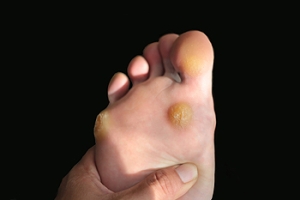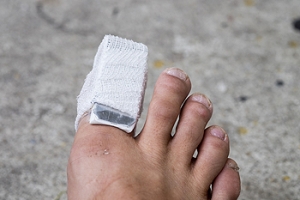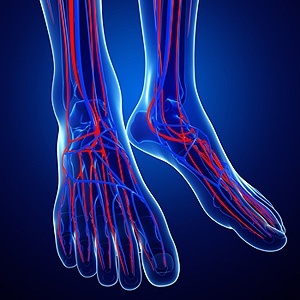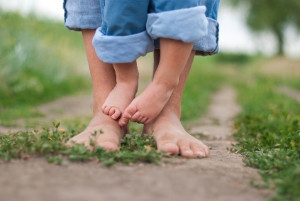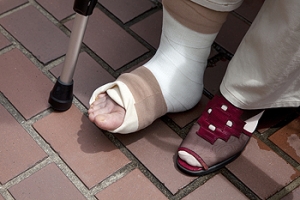
Causes of Corns
 If you experience a bony knot on your toes or feet, you may have what is referred to as a hard corn. This is generally the result of the friction the feet endure, commonly due to poorly fitting shoes. Corns that appear between the toes often have a soft texture and occur when shoes are worn with a narrow toe area. Both types of corns can be painful and uncomfortable and may need to be treated, depending upon the severity. Choosing to wear shoes that fit correctly will not only feel more comfortable, but will aid in the treatment and prevention of corns. If there are additional foot problems present, such as diabetes, or any type of surgery performed that may have affected the bone structure, it’s important to relay that information to your podiatrist.
If you experience a bony knot on your toes or feet, you may have what is referred to as a hard corn. This is generally the result of the friction the feet endure, commonly due to poorly fitting shoes. Corns that appear between the toes often have a soft texture and occur when shoes are worn with a narrow toe area. Both types of corns can be painful and uncomfortable and may need to be treated, depending upon the severity. Choosing to wear shoes that fit correctly will not only feel more comfortable, but will aid in the treatment and prevention of corns. If there are additional foot problems present, such as diabetes, or any type of surgery performed that may have affected the bone structure, it’s important to relay that information to your podiatrist.
If you have any concerns regarding your feet and ankles, contact James P. Huish, DPM of Arizona. Our doctors will treat your foot and ankle needs.
Corns: What Are They? and How Do You Get Rid of Them?
Corns can be described as areas of the skin that have thickened to the point of becoming painful or irritating. They are often layers and layers of the skin that have become dry and rough, and are normally smaller than calluses.
Ways to Prevent Corns
There are many ways to get rid of painful corns such as wearing:
- Well-fitting socks
- Comfortable shoes that are not tight around your foot
- Shoes that offer support
Treating Corns
Treatment of corns involves removing the dead skin that has built up in the specific area of the foot. Consult with Our doctors to determine the best treatment option for your case of corns.
If you have any questions please feel free to contact our office located in Safford and Sierra Vista, AZ . We offer the newest diagnostic and treatment technologies for all your foot and ankle needs.
Corns: What Are They, and How Do You Get Rid of Them
Corns are thickened areas on the skin’s surface, to the point of being irritating and sometimes painful. Commonly found on the feet, corns are circular or cone-shaped. They develop where there are areas of pressure or friction, such as on the little toe when it rubs up against shoes, or on the ball of your foot.
Corns are often confused with a callus, but there is a difference between them. Corns can be raised bumps that are painful to the touch. They consist of a rough, thick area of skin that may be dry or waxy. Corns tend to be surrounded by skin that is inflamed, and are usually much smaller than calluses.
Removing the dead skin that has built up is the key in treating corns. Salicylic acid medication is most common in accomplishing this. The acid works by dissolving keratin, which is the protein that makes up the majority of corns. You can purchase salicylic acid over-the-counter in products such as wart removers. It comes in a variety of forms such as medicated pads, drops, or creams. However, people who are diabetic should not use salicylic acid, but should instead consult their doctor immediately.
According to the product directions, applying the medication directly onto the corn will treat it. The top layer of the corn will begin to turn white after use. When that occurs, the layers of skin can then be peeled away, making the corn smaller. Shaving off corns with razors or other pedicure equipment is never a good idea. This can lead to infection. If your corn gets infected, and is not treated immediately, a visit to the doctor will be necessary.
Another way to treat corns and help prevent their return is by using orthotic inserts, fitted by a podiatrist. Inserts fit right into your shoes and adjusts the way your foot fits into your shoes. This fixes the way you walk. This will lower your chances of getting corns, and eliminate current corns by reducing rubbing from friction.
Surgery is rarely used to treat corns, but does occur on occasion. Surgery actually deals with the underlying issue that causes corns. During surgery, the bone is shaved and any abnormalities are corrected, thus reducing the amount of friction that occurs during walking.
To prevent corns, the first step is reducing friction. Always wear shoes that fit well and don’t rub your feet. Pads can be purchased if you notice rubbing developing. These pads can be purchased over-the-counter, and can be simply placed on the irritated area. Wearing cushioned insoles in your shoes can always reduce the friction, and making sure to wear well-fitting shoes. This will ensure that your foot is not being squeezed awkwardly, and prevent corns from forming in the first place.
Symptoms of a Broken Toe
 If you have fallen and have experienced severe pain at the top of the foot, you may have what is referred to as a broken toe. Additionally, this may occur if a heavy object has fallen on the toe and will often appear bruised and swollen. Fractures that are severe may cause the toe to become displaced, causing the toe to look deformed. It’s important to begin treatment of this condition as quickly as possible, often beginning with taking weight off the toe. At this point, the toe can be splinted to the toe next to it, which will restrict any movement from occurring. To properly diagnose this ailment, an X-ray may be performed to observe the severity of the fracture. If the big toe is broken, a walking boot may be suggested to be worn, typically for 2-4 weeks. If you feel you have broken your toe, please consider scheduling a consultation with a podiatrist for a proper evaluation.
If you have fallen and have experienced severe pain at the top of the foot, you may have what is referred to as a broken toe. Additionally, this may occur if a heavy object has fallen on the toe and will often appear bruised and swollen. Fractures that are severe may cause the toe to become displaced, causing the toe to look deformed. It’s important to begin treatment of this condition as quickly as possible, often beginning with taking weight off the toe. At this point, the toe can be splinted to the toe next to it, which will restrict any movement from occurring. To properly diagnose this ailment, an X-ray may be performed to observe the severity of the fracture. If the big toe is broken, a walking boot may be suggested to be worn, typically for 2-4 weeks. If you feel you have broken your toe, please consider scheduling a consultation with a podiatrist for a proper evaluation.
A broken toe can be very painful and lead to complications if not properly fixed. If you have any concerns about your feet, contact James P. Huish, DPM from Arizona. Our doctors will treat your foot and ankle needs.
What to Know About a Broken Toe
Although most people try to avoid foot trauma such as banging, stubbing, or dropping heavy objects on their feet, the unfortunate fact is that it is a common occurrence. Given the fact that toes are positioned in front of the feet, they typically sustain the brunt of such trauma. When trauma occurs to a toe, the result can be a painful break (fracture).
Symptoms of a Broken Toe
- Throbbing pain
- Swelling
- Bruising on the skin and toenail
- The inability to move the toe
- Toe appears crooked or disfigured
- Tingling or numbness in the toe
Generally, it is best to stay off of the injured toe with the affected foot elevated.
Severe toe fractures may be treated with a splint, cast, and in some cases, minor surgery. Due to its position and the pressure it endures with daily activity, future complications can occur if the big toe is not properly treated.
If you have any questions please feel free to contact our office located in Safford and Sierra Vista, AZ . We offer the newest diagnostic and treatment technologies for all your foot and ankle needs.
What to Know About a Broken Toe
Trauma to the foot, especially the toes, can occur in many ways. Banging them, stubbing them, or dropping something on them are a few different ways this trauma can occur. Given the fact that toes are positioned in front of the feet, they typically sustain the brunt of such trauma. When trauma occurs to a toe, the result can be a painful break or fracture. Another type of trauma that can break a toe is repeated activity that places stress on the toe for prolonged periods of time.
Broken toes can be categorized as either minor or severe fractures. Symptoms of minor toe fractures include throbbing pain, swelling, bruising on the skin and toenail, and the inability to move the toe with ease. Severe toe fractures require medical attention and are indicated when the broken toe appears crooked or disfigured, when there is tingling or numbness in the toe, or when there is an open, bleeding wound present on the toe.
Generally, a minor toe break will heal without long-term complications. However, it is important to discontinue activities that put pressure on the toe. It is best to stay off of the injured toe and immediately get a splint or cast to prevent any more additional movement of the toe bones. You can also immobilize your toe by placing a small cotton ball between the injured toe and the toe beside it. Then, tape the two toes together with medical tape. Swelling can be alleviated by placing an ice pack on the broken toe directly as well as elevating your feet above your head.
Severe toe fractures may be treated with a splint, cast, and in some cases, minor surgery, especially when the big toe has been broken. Due to its position and the pressure the big toe endures with daily activity, future complications can occur if it is not properly treated. Pain associated with minor toe fractures can be managed with over-the-counter pain medications. Prescription pain killers may be necessary for severe toe fractures.
The healing time for a broken toe is approximately four to six weeks. In severe cases where the toe becomes infected or requires surgery, healing time can take up to eight weeks or more. While complications associated with a broken toe are immediately apparent, it is important to note that there are rare cases when additional complications, such as osteoarthritis, can develop over time. You should immediately speak with your podiatrist if you think you have broken your toe due to trauma. They will be able to diagnose the injury and recommend the appropriate treatment options.
Symptoms and Causes of Neuropathy
 Peripheral neuropathy is a condition that affects the nerves in the peripheral nervous system. The nerves become damaged and as a result, this type of neuropathy develops. The symptoms that accompany neuropathy include numbness, tingling or a burning sensation and will most often affect the feet. Additional symptoms may include a loss of balance and it’s common to experience weakness. There are several causes that may promote the onset of this ailment, including a vitamin deficiency, kidney failure, shingles, or alcoholism. Additionally, this condition may be the result of certain chemotherapy drugs that are taken. It’s important to have a correct diagnosis performed so the proper medication can be taken to alleviate the symptoms. It is suggested to consult with a podiatrist if your feet are affected by neuropathy.
Peripheral neuropathy is a condition that affects the nerves in the peripheral nervous system. The nerves become damaged and as a result, this type of neuropathy develops. The symptoms that accompany neuropathy include numbness, tingling or a burning sensation and will most often affect the feet. Additional symptoms may include a loss of balance and it’s common to experience weakness. There are several causes that may promote the onset of this ailment, including a vitamin deficiency, kidney failure, shingles, or alcoholism. Additionally, this condition may be the result of certain chemotherapy drugs that are taken. It’s important to have a correct diagnosis performed so the proper medication can be taken to alleviate the symptoms. It is suggested to consult with a podiatrist if your feet are affected by neuropathy.
Peripheral artery disease can pose a serious risk to your health. It can increase the risk of stroke and heart attack. If you have symptoms of peripheral artery disease, consult with James P. Huish, DPM from Arizona. Our doctors will assess your condition and provide you with quality foot and ankle treatment.
Peripheral artery disease (PAD) is when arteries are constricted due to plaque (fatty deposits) build-up. This results in less blood flow to the legs and other extremities. The main cause of PAD is atherosclerosis, in which plaque builds up in the arteries.
Symptoms
Symptoms of PAD include:
- Claudication (leg pain from walking)
- Numbness in legs
- Decrease in growth of leg hair and toenails
- Paleness of the skin
- Erectile dysfunction
- Sores and wounds on legs and feet that won’t heal
- Coldness in one leg
It is important to note that a majority of individuals never show any symptoms of PAD.
Diagnosis
While PAD occurs in the legs and arteries, Podiatrists can diagnose PAD. Podiatrists utilize a test called an ankle-brachial index (ABI). An ABI test compares blood pressure in your arm to you ankle to see if any abnormality occurs. Ultrasound and imaging devices may also be used.
Treatment
Fortunately, lifestyle changes such as maintaining a healthy diet, exercising, managing cholesterol and blood sugar levels, and quitting smoking, can all treat PAD. Medications that prevent clots from occurring can be prescribed. Finally, in some cases, surgery may be recommended.
If you have any questions, please feel free to contact our office located in Safford and Sierra Vista, AZ . We offer the newest diagnostic and treatment technologies for all your foot care needs.
Peripheral Artery Disease
Peripheral artery disease (PAD), or peripheral arterial disease, is a circulatory problem in which there is a reduction of blood flow to the limbs due to narrowed arteries. When peripheral artery disease develops, the extremities do not receive enough blood flow; this may cause symptoms to develop such as claudication, or leg pain when walking. The legs are the most common site of peripheral artery disease.
Claudication, or leg pain when walking, is one of several symptoms that can develop due to peripheral artery disease. Other symptoms caused by the disease include painful cramping in the hips, thighs, or calves after certain activities; leg numbness or weakness; coldness in the lower leg or foot; sores on the lower extremities that do not heal; hair loss on the lower extremities; and a missing or weak pulse in the lower extremities. In more severe cases, pain may even occur when the body is at rest or when lying down.
Peripheral artery disease is typically caused by atherosclerosis, a condition in which fatty deposits build up in the arterial walls and reduce blood flow. Smoking, diabetes, obesity, high blood pressure, and high cholesterol are some of the risk factors for peripheral artery disease.
If you are experiencing pain, numbness, or other symptoms in the lower extremities, see your healthcare professional immediately. Diagnosed peripheral artery disease can be treated with various medications, angioplasty and surgery, exercise programs, or alternative medicine. It is important to consult a healthcare professional to determine the best treatment for you.
The Importance of Proper Foot Care in Children
 When babies' feet have ample room to move about in, the muscles in the feet become stronger by kicking and wiggling the toes. Research has shown that it’s not necessary for babies to wear shoes unless the weather is cold when they are taken outside. Babies feet grow rapidly, and it is beneficial to monitor the size of the shoes and socks that are worn for optimum comfort. Washing and drying the feet is a good hygiene practice to implement daily with extra attention taken to thoroughly dry between the toes which may prevent excess moisture from developing. Most children begin to walk about 12 months of age and it may be beneficial to notice if the child’s feet or toes turn out. Wearing shoes that fit properly will aid in comfortable walking, and choosing shoes that are made of lightweight materials will allow the feet to breath. If you would like additional information about how to choose proper shoes for your child, please schedule a consultation with a podiatrist.
When babies' feet have ample room to move about in, the muscles in the feet become stronger by kicking and wiggling the toes. Research has shown that it’s not necessary for babies to wear shoes unless the weather is cold when they are taken outside. Babies feet grow rapidly, and it is beneficial to monitor the size of the shoes and socks that are worn for optimum comfort. Washing and drying the feet is a good hygiene practice to implement daily with extra attention taken to thoroughly dry between the toes which may prevent excess moisture from developing. Most children begin to walk about 12 months of age and it may be beneficial to notice if the child’s feet or toes turn out. Wearing shoes that fit properly will aid in comfortable walking, and choosing shoes that are made of lightweight materials will allow the feet to breath. If you would like additional information about how to choose proper shoes for your child, please schedule a consultation with a podiatrist.
The health of a child’s feet is vital to their overall well-being. If you have any questions regarding foot health, contact James P. Huish, DPM of Arizona. Our doctors can provide the care you need to keep you pain-free and on your feet.
Tips for Keeping Children's Feet Healthy
- Make sure their shoes fit properly
- Look for any signs of in-toeing or out-toeing
- Check to see if they have Clubfoot (condition that affects your child’s foot and ankle, twisting the heel and toes inward) which is one of the most common nonmajor birth defects.
- Lightly cover your baby’s feet (Tight covers may keep your baby from moving their feet freely, and could prevent normal development)
- Allow your toddler to go shoeless (Shoes can be restricting for a young child’s foot)
- Cut toenails straight across to avoid ingrown toenails
- Keep your child’s foot clean and dry
- Cover cuts and scrapes. Wash any scratches with soap and water and cover them with a bandage until they’ve healed.
If you have any questions, please feel free to contact our office located in Safford and Sierra Vista, AZ . We offer the newest diagnostic and treatment technologies for all your foot care needs.
What to Do to Keep Your Child’s Feet Healthy
Being a parent involves caring for your child in every way you can. You make sure they are eating the right food, being nice to others, and staying out of any trouble. However, it is also important that you are watchful of their health, more specifically their foot health. Maintaining good foot health in childhood is important in preventing later conditions in life from happening. As children continue to develop, their feet require different techniques of care. Here are some various ways in which you can help your child’s feet stay healthy.
A baby needs a lot of care and attention overall, but the importance of their feet should never be forgotten. Before a baby turns one, their feet change and develop greatly. It is important that during this time, a mother avoids putting tight socks on their child. She should also encourage movement of their feet so the baby can begin to feel more comfortable using them.
As a baby enters the toddler years of his or her life, they are begin to walk around. When your baby begins to take those first steps, it is crucial that they are wearing protective shoes on their feet. As a mother that is observant of your child’s feet, you may notice changes in them. This is completely normal as the feet are becoming susceptible to the activity of walking. It is normal for a toddler to be a bit unsteady or to “walk funny” at first.
When your child grows out of their toddler years, it is important that you begin to show him or her how to care for their feet on their own. Practice with your child proper hygiene in order to prevent foot fungus or infection. Since children are constantly on the move, it is crucial to be cautious of any accidents or injuries that might occur. If an injury occurs, it is advised that you take your child to be examined by a doctor immediately. Since your child is still growing, particular injuries can shift the way in which a bone or other important part of the foot is developing.
Babies and kids are always changing and growing. Your job as a parent is to make sure they stay healthy and making sure they are properly maintained. This involves proper foot care and making sure the feet stay healthy. Following this guide, your child can live a long and happy life.
Have I Broken My Ankle?
 If you have suffered a traumatic ankle injury that may result in swelling, severe pain and bruising, you may have broken your ankle. Most broken ankles occur from a fall, which causes one or more of the ankle bones to fracture. Occasionally, if jumping from an extended height occurs, the joints may undergo extreme flexing, which may cause a broken ankle. It’s important to take all weight off the ankle as soon as possible, and this is typically accomplished by immobilizing the ankle in a cast. Research has shown that six weeks is the average time a cast is worn, which typically allows ample time for the ankle bone to heal. For severe breaks, surgery may be necessary to adequately repair the bone, which may include inserting metal pins or plates. It’s beneficial to begin a rehabilitation program when the cast is removed. This may ensure proper mobility. Please speak to a podiatrist if you have broken your ankle for additional information.
If you have suffered a traumatic ankle injury that may result in swelling, severe pain and bruising, you may have broken your ankle. Most broken ankles occur from a fall, which causes one or more of the ankle bones to fracture. Occasionally, if jumping from an extended height occurs, the joints may undergo extreme flexing, which may cause a broken ankle. It’s important to take all weight off the ankle as soon as possible, and this is typically accomplished by immobilizing the ankle in a cast. Research has shown that six weeks is the average time a cast is worn, which typically allows ample time for the ankle bone to heal. For severe breaks, surgery may be necessary to adequately repair the bone, which may include inserting metal pins or plates. It’s beneficial to begin a rehabilitation program when the cast is removed. This may ensure proper mobility. Please speak to a podiatrist if you have broken your ankle for additional information.
Broken ankles need immediate treatment. If you are seeking treatment, contact James P. Huish, DPM from Arizona. Our doctors can provide the care you need to keep you pain-free and on your feet.
Broken Ankles
A broken ankle is experienced when a person fractures their tibia or fibula in the lower leg and ankle area. Both of these bones are attached at the bottom of the leg and combine to form what we know to be our ankle.
When a physician is referring to a break of the ankle, he or she is usually referring to a break in the area where the tibia and fibula are joined to create our ankle joint. Ankles are more prone to fractures because the ankle is an area that suffers a lot of pressure and stress. There are some obvious signs when a person experiences a fractured ankle, and the following symptoms may be present.
Symptoms of a Fractured Ankle
- Excessive pain when the area is touched or when any pressure is placed on the ankle
- Swelling around the area
- Bruising of the area
- Area appears to be deformed
If you suspect an ankle fracture, it is recommended to seek treatment as soon as possible. The sooner you have your podiatrist diagnose the fracture, the quicker you’ll be on the way towards recovery.
If you have any questions, please feel free to contact our office located in Safford and Sierra Vista, AZ . We offer the newest diagnostic and treatment technologies for all your foot care needs.
All About Broken Ankles
Broken ankles are a serious injury that can lead to an inability to walk, function, and also cause a significant amount of pain. A broken ankle is a break in one of the three bones in your body that connect at the ankle joint: the tibia, the fibula, and the talus. The tibia and fibula are your two primary leg bones that connect at the knee, which sit directly upon the talus bone. This is protected by a fibrous membrane that allows for movement in the ankle joint. A broken ankle is usually caused by the foot rolling under or twisting too far, causing one of these three bones to snap.
A broken ankle is different from an ankle sprain, which occurs when the ankle ligaments are ripped or torn but no bones have been broken. A sprain can still be very severe, causing bruising in the foot and an inability to hold your own weight, much like a broken ankle would. If you’re unable to stand, and suspect that you have a broken ankle, the first thing to do would be to get an immediate X-ray to determine the severity of the break.
A common cause of broken ankles is when the ankle is rolled over with enough pressure to break the bones. This usually happens during exercise, sports, or other physical activity. Another common cause is a fall or jump from a tall height.
One immediate treatment for pain relief is elevating the foot above your head to reduce blood flow to the injured area. You can also apply ice packs to your ankle to help reduce swelling, redness, inflammation, and pain. After these initial steps, getting a cast and staying off your feet as much as possible will aid in the recovery of the broken ankle. The less movement and stress the ankle has to endure, the more complete it will heal. A doctor can determine if surgery is needed in order to heal correctly. In these cases, an operation may be the only option to ensure the ability to walk properly again, followed by physical therapy and rehabilitation.
It is highly important to determine if surgery is needed early on, because a broken ankle can become much more severe than you realize. If not professionally treated, the broken ankle will inhibit your walking, daily functioning, and produce a large amount of pain. Treating your broken ankle early on will help prevent further damage to it.
